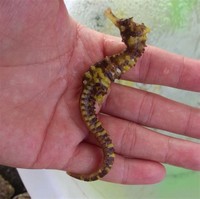Facts about Seahorse

Animals sold as "freshwater seahorses" are usually the closely related pipefish, of which a few species live in the lower reaches of rivers.

Some species are especially dangerous to the slow-moving seahorses and should be avoided completely: eels, tangs, triggerfish, squid, octopus, and sea anemones (Wooten 2004).
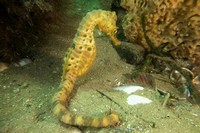
Seahorses, as with most genera of Syngnathidae, have this brood organ on the tail, rather than the trunk (Nelson 2006).

The female gastric-brooding frogs (genus Rheobatrachus) from Australia, now probably extinct, swallows its tadpoles, which then develop in the stomach.
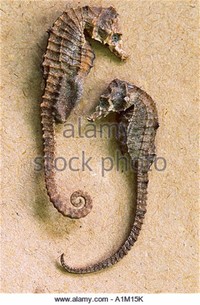
The seahorse is used in traditional Chinese herbology, and as many as 20 million seahorses may be caught each year and sold for this purpose (PBS 1997).

Seahorses form territories, with males staying in about one square meter of their habitat while females range about one hundred times that area.

Throughout the male’s incubation, his mate may visit him daily for “morning greetings.” The female seahorse swims over for about 6 minutes of interaction reminiscent of courtship.
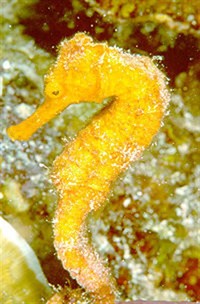
Nelson (2006) places seahorses in the suborder Syngnathoidei within Gasterosteiformes.
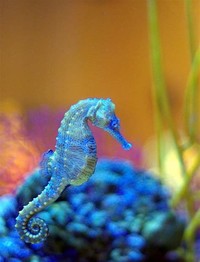
The Hippocampus genus, the seahorses, is one of about 50 genera in Syngnathidae, but is the only genus in the subfamily Hippocampinae (Nelson 2006).

Seahorses can co-exist with many species of shrimp and other bottom-feeding creatures.

Seahorses swim very poorly by using a dorsal fin, which they rapidly flutter to propel them, and pectoral fins, located behind their eyes, which they use to steer.

Import and export of seahorses has been controlled under CITES since May 15, 2004.

Seahorses once had to be of a certain size and quality before they were accepted by TCM practitioners and consumers.

Seahorse populations are thought to have been endangered in recent years by overfishing and habitat destruction.

Seahorses swim upright, another characteristic that is not shared by their close pipefish relatives, which swim horizontally.

Seahorses are slow feeders, and in an aquarium with fast, aggressive feeders, the seahorses will be edged out in the competition for food.

During social moments or in unusual surroundings, seahorses turn bright colors.

To correct for oxygen used by the growing brood, Masonjones managed to keep ј inch-high premature seahorses alive outside the pouch so she could measure their oxygen needs.

According to Amanda Vincent of Project Seahorse, only males tail-wrestled and even snap their heads toward each other.

Syngnathidae, the family to which seahorses belong, is variously placed in the Syngnathiformes or Gasterosteiformes order.

Like almost all other fish species, seahorses do not care for their young once they are born.

Medicinal seahorses are not readily bred in captivity as they are susceptible to disease and are considered to have somewhat different energetics than aquarium seahorses.

The earliest known seahorse fossils are of a pipefish-like species from the "Coprolitic Horizon" of Tunjice hills, a lower Miocene lagerstatten in Slovenia dating back about 13 million years.

The supposed true "freshwater seahorse" called Hippocampus aimei was not a real species, but a name sometimes used for individuals of Barbour's seahorse (Hippocampus barbouri) and hedgehog seahorse (Hippocampus spinosissimus).

Seahorses are found in tropical and warm temperate marine waters throughout the world.

Within the seahorse species, males are shown to be the more aggressive sex and sometimes “fight” for female attention.

Anatomical evidence, supported by molecular and genetic evidence, suggests that seahorses are highly modified pipefish.

Another study conducted by Amanda Vincent of Project Seahorse shows the importance of this daily ritual.

Seahorses have a coronet on their head, which is distinct to each seahorse, much like a human fingerprint.

Seahorses should be kept in an aquarium to themselves, or with compatible tank-mates.

Hippocampus erectus are larger seahorses found anywhere from Nova Scotia down to around Uruguay.


